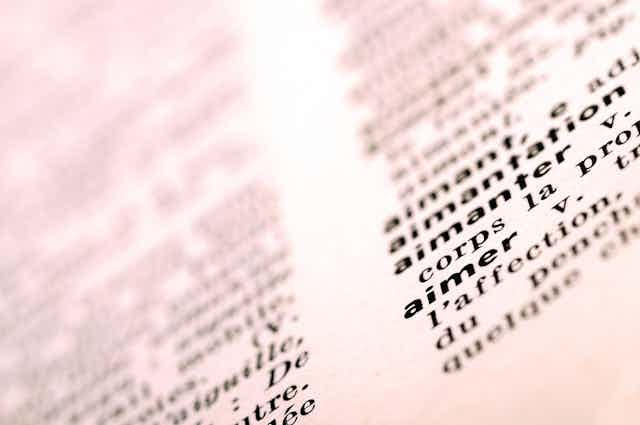In a recent statement, the Académie française warned that a new set of writing conventions, commonly referred to as “l’écriture inclusive” (inclusive writing), is putting the French language in “mortal danger”.
The controversy, sparked by the introduction of the conventions in a recent primary school manual, has led to front page headlines, TV debates, and twitter spats. Inclusive writing aims to make the French language less sexist.
Traditionally, the norm has been that “the masculine prevails over the feminine”, as all French school children are taught. For example, a group of female party activists will be referred to as “des militantes” (feminine gender), but if one or more males join the group, they will be called “des militants” (masculine gender), thereby masking the female presence in the group. The advocates of inclusive writing propose to make both genders visible, using either the “point médian” (middle dot), so it would be rendered “militant·e·s”, or an epicene noun (both masculine and feminine) such as “les membres du parti” (party members).
They also advocate the systematic feminisation of job titles – even in professions where the masculine is the default form – for example: “un ingénieur” (male) and “une ingénieure” (female) for engineer. Or “un écrivain” (male) and “une écrivaine” (female) for writer (plural: “les écrivain·e·s”). There is also a push to avoid the so-called “generic masculine” whereby man symbolises mankind as a whole: “les droits de l’Homme” (human rights) becomes “les droits humains”.
These recommendations came about when France’s High Council for Equality between Women and Men published a guide in 2015 explicitly encouraging public bodies to adopt a form of communication without gender stereotypes.
Unsurprisingly, however, the Académie française, commonly recognised as the “gatekeeper” of the French language, vehemently opposes inclusive writing.
The Académie does not have the most sparkling record when it comes to gender equality: since its creation in 1635, it has had 729 members – of these, eight have been women (the first of whom was elected only in 1980). They themselves request to be referred to in the masculine form – which the Académie insists is a neuter form when it comes to professions and titles (so, “Madame le Président” rather than “Madame la Présidente”).
But the Académie is not the only opponent of this development, as a quick search of #ecritureinclusive on Twitter will confirm. The minister for Education, for example, has rejected it as on the basis that it adds “a layer of complexity” to and “degrades” the language.
Philosopher Raphaël Enthoven has fuelled the polemic by accusing promoters of inclusive writing of brainwashing people and comparing it to Orwell’s Newspeak. Yet, for supporters of inclusive writing, removing the systemic gender bias in the French language is important, because French is not sexist by chance but rather by design: the feminine has been deliberately sidelined in the process of codifying the language in grammars and dictionaries.

Author and academic Eliane Viennot observes that feminine terms such as “autrice” (author) or “philosophesse” (philosopher) were in use until the 17th century, when language commentators removed them from dictionaries for their supposed impropriety. She also reminds us that the rule that “the masculine prevails over the feminine” only became compulsory when (mostly male) grammarians argued that language should follow the social order in which they operated.
Thus, in 1767 grammarian Nicolas Beauzée asserted that masculine forms were “nobler” than feminine forms because of the “superiority” of males over females. Advocates of inclusive writing conclude that the rule in itself fosters gender stereotypes in society, as is made apparent by the illustrations chosen in some grammar books.

Most of the resistance to l’écriture inclusive focuses on the point median. The feminisation of professions and job titles, however, has made progress over the past 20 years. When the government first encouraged it, words such as écrivaine were largely rejected as “ugly”. Now, the newly appointed French representative for La Francophonie, author Leïla Slimani, who won the prestigious Prix Goncourt in 2016, proudly presents herself as an “écrivaine”.
While the current prime minister still referred to female members of his cabinet as “Madame LE ministre” when he was appointed in May, he now seems to have adopted the feminine form “Madame LA Ministre” (as this speech shows). The same now goes for the overwhelming majority of French deputies.
In this respect, l’écriture inclusive has two allies. The first is the French used outside of France, which has not been held back by the Académie – Montréal just elected its first “mairesse”, a word which for a long time was reserved for the wife of a mayor. The second is technology – word-processing software such as Microsoft Word will now encourage inclusive writing, in the same way as they allowed previous reform – such as the 1990 spelling reform – to spread.
The 1990 reform proposed to simplify the spelling of about 2,000 words, removing the circumflex accent on many of them in particular. The changes were never enforced but word processors which no longer correct forms such as “connait” (instead of “connaît”) have allowed them to spread.
Likewise, the AFNOR (the French Association for Standardisation) which is designing a new keyboard better suited to the French language has announced that it will include a key for the middle dot.
What is more, a number of media outlets and institutions – such as the prestigious engineering school CNAM – have already announced that they are adopting inclusive writing conventions.
So it would appear that the stance adopted by the Académie française is not shared by all French speakers, perhaps signalling that the cries of “danger” made by les immortel·le·s will go unheeded.

